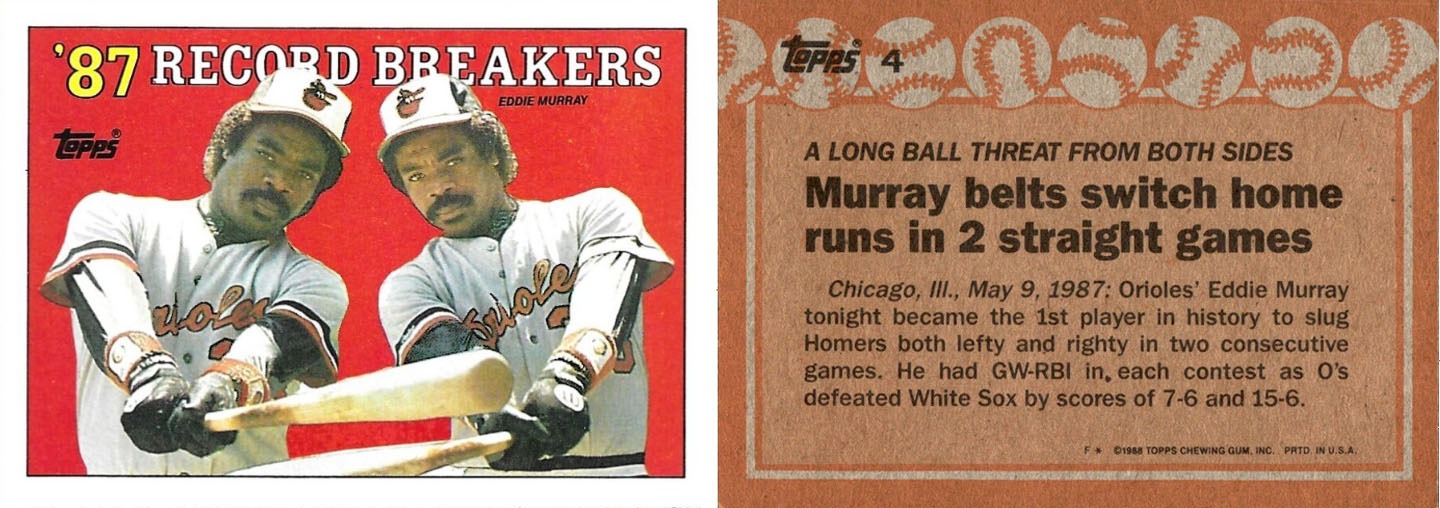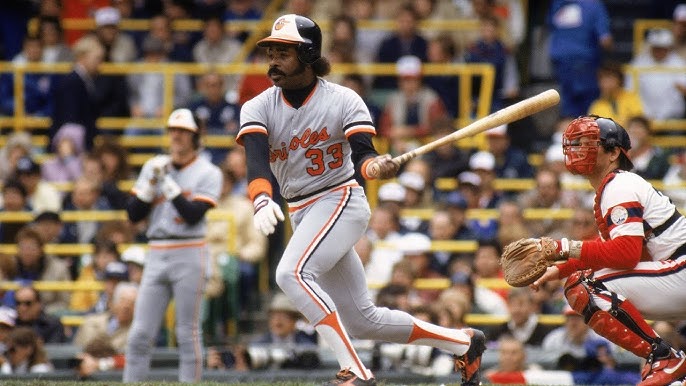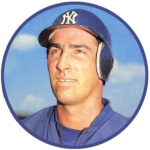Switched On

We enter the v28 era on a somewhat paradoxical note. The final member of the v26 Club, Candy Maldonado, had a career that was wholly enveloped by that of the first v28 Club member, Eddie Murray.
Eddie Murray brings a few new characteristics to the table for Club members.
First to be enshrined in Cooperstown
First Rookie of the Year
First to play for the Orioles franchise1
First switch-hitter
Eddie Murray was a prolific power hitter. He ranks second, behind Mickey Mantle, in home runs hit by a switch-hitter. He could hit from either side of the plate with ease, sometimes hitting home runs from both sides of the plate in the same game. Then sometimes hitting home runs from both sides of the in the same game in consecutive games, as his 1988 Topps Record Breaker baseball card describes. But did he hit a home run from both sides of the plate against every opponent? Let’s dive in.
Early Eddie
A freshly drafted seventeen-year-old Murray started his career with the Orioles in Bluefield of the Appalachian League in 1973. He then methodically moved through the ranks for the next three years with stops in Miami, Asheville, Charlotte, and Rochester. Each year he posted double-digit home run totals and held a .281 average through the four years.
Murray broke camp with the big league team in 1977. He immediately found himself in a position we’ve thus far seen reserved for late-career v-Club inductees. Lee May blocked his path to regular playing time at first, but Murray’s bat could not be ignored, so Earl Weaver started him at designated hitter more than 70% of the time.
By the time the All-Star break rolled around, Murray had collected thirteen home runs with seven of them being ledgers. He also collected home runs from both sides of the plate against four of the ledgered teams.
LEDGER ONE: April 18, 1977 vs Cleveland Indians (Hit it left-handed (LH); Hit his first right-handed home run (RH) against the Indians on April 20, 1977)
LEDGER TWO: April 26, 1977 vs New York Yankees (RH; LH on July 10, 1977)
LEDGER THREE: April 30, 1977 vs California Angels (LH; RH on June 5, 1978)
LEDGER FOUR: May 7, 1977 vs Seattle Mariners (RH; LH on May 8, 1977)
The Mariners would prove to be Murray’s American League kryptonite. He would only hit eighteen more against them in his career, fewer than any AL opponent.
LEDGER FIVE: May 23, 1977 vs Milwaukee Brewers (LH; RH on July 24, 1977, Game 2)
LEDGER SIX: June 8, 1977 at Boston Red Sox (LH; RH on July 3, 1977)
LEDGER SEVEN: July 4, 1977 vs Detroit Tigers (LH; RH on June, 1979, Game 1)
Murray’s first ledger after the All-Star break was part his first career multi-homer game.
LEDGER EIGHT: August 3, 1977 at Oakland Athletics (LH; RH on August 3, 1977)
This was also the first instance of Murray hitting a home run from both sides of the plate in a game. His ledger was hit off righty Dave Giusti and extended the Orioles’ lead in the top of the eighth. Lefty Bob Lacey gave up Murray’s second home run in the top of the tenth, and it would end up being the game winner.
Murray concluded the 1977 campaign with nine more home runs and ledgers against the White Sox and the Blue Jays.
LEDGER NINE: September 4, 1977 at Chicago White Sox (LH; RH on August 14, 1979)
LEDGER TEN: September 20, 1977 vs Toronto Blue Jays (LH; RH on September 9, 1978)
All told, Murray’s season ended with 27 home runs, 88 RBI, and a .283 average which mirrored, if not bettered, his minor league campaigns. He received twelve first place votes on the way to winning the AL Rookie of the Year award.
1978 saw Murray and Lee May flip their positions as the 22-year-old Murray was installed as the Orioles’ first baseman while the 34-year-old May became the every day designated hitter. His sophomore year was slightly better with a handful more RBI and a couple points on his batting average. He also added two ledgers.
LEDGER ELEVEN: April 12, 1978 at Kansas City Royals (LH; RH on August 11, 1980)
LEDGER TWELVE: May 12, 1978 at Texas Rangers (RH; LH on July 24, 1978)
Despite big home run totals through his first two seasons, the Twins eluded him as an opponent. More opposition kryptonite, if you will. That trend continued through the first few months of 1979 too. In his 117th plate appearance against the Twins, he finally broke through.
LEDGER THIRTEEN: August 29, 1979 (Game 2) at Minnesota Twins (RH; LH on August 29, 1979, Game 2)
In his 118th plate appearance against the Twins, he added another home run against them. Then, in his 119th plate appearance he added his third. It was his first three-home run game in his career, and fourth multi-homer game. This was also the second instance of hitting home runs from both sides of the plate; off lefty Geoff Zahn in the fifth and seventh inning, then righty Mike Marshall in the ninth.
Murray turned playing the Twins into his anti-kryptonite. He ended up hitting more home runs (44) against them in his career than any other team.
At this point, Murray was maxed out in the American League. He would play in Baltimore for nine more seasons, earning All-Star selections and/or MVP votes in all but two seasons. But Murray’s professional relationships became strained as it was perceived his production was dipping, which it did in conjunction with an injury in 1986, but rebounded in in 1987 and 1988. Media members remained personas non grata. Murray was critical of management for not maintaining a championship caliber team after the 1983 World Series win.
So, perhaps unsurprisingly, the Orioles traded away Murray after the 1988 season.
Ready Eddie
He landed in Los Angeles with the Dodgers and got to work immediately. His home run totals started to lag slightly, but that didn’t stop him from knocking eight ledgers in his first season.
LEDGER FOURTEEN: April 10, 1989 at San Francisco Giants (LH; RH on April 23, 1989)
LEDGER FIFTEEN: April 14, 1989 vs Houston Astros (LH; RH on July 12, 1992)
LEDGER SIXTEEN: April 30, 1989 at St. Louis Cardinals (LH; RH on June 16, 1991)
LEDGER SEVENTEEN: May 14, 1989 at Philadelphia Phillies (LH; no RH home runs)
This is where we answer the question posed in this article’s introduction. No, Murray did not hit home runs from both sides of the plate against every opponent. His first home run versus the Phillies came against right-hander Alex Madrid. Alex Madrid only allowed four home runs in his entire career, and Murray’s was the last.
Murray hit three more home runs against Philadelphia righties in his career, but in 116 plate appearances against lefties, he never tallied a homer run.
LEDGER EIGHTEEN: June 21, 1989 at San Diego Padres (LH; RH on June 9, 1990)
LEDGER NINETEEN: July 7, 1989 at Chicago Cubs (RH; LH on July 8, 1989)
LEDGER TWENTY: August 18, 1989 at New York Mets (LH; RH on August 20, 1989)
LEDGER TWENTY-ONE: September 7, 1989 at Cincinnati Reds (RH; LH on September 11, 1989)
LEDGER TWENTY-TWO: September 15, 1989 vs Atlanta Braves (LH; RH on April 22, 1991)
Murray ended 1989 with twenty home runs and would increase that total to 26 in 1990 which included two more ledgers which would make him maxed out in the National League.
LEDGER TWENTY-THREE: May 1, 1990 vs Pittsburgh Pirates (LH; RH on August 8, 1993)
LEDGER TWENTY-FOUR: May 9, 1990 at Montreal Expos (LH; RH on September 19, 1992)
1990 would be the last season where Murray garnered MVP votes, and 1991 would feature his last All-Star Game selection. He entered free agency after the 1991 season and would end up signing with the Mets.
Steady Eddie
We last mentioned Murray’s age back when he was a 22-year-old moving to playing first base. He was now in his age 36 season but still managed to play in 150+ games in both seasons he played for the Mets. His signing offered up a necessary ledger possibility, which he collected on in May.
LEDGER TWENTY-FIVE: May 17, 1992 at Los Angeles Dodgers (LH; no RH home runs)
This would be the second instance of Murray not getting a home run from both sides of the plate against an opponent. He would hit three more home runs against Dodgers’ righties in his career.
1993 saw resurgent home run and RBI totals for Murray, which couldn’t have hurt to collect ledgers against the two expansion teams before he would more-or-less depart the National League to finish his career on the Junior Circuit.
LEDGER TWENTY-SIX: May 8, 1993 vs Florida Marlins (LH; RH on June 29, 1993)
LEDGER TWENTY-SEVEN: August 26, 1993 vs Colorado Rockies (LH; no RH home run)
This was the only home run Murray would hit against the Rockies in his career. Otherwise, he would end up collecting at least three home runs against every opponent.
“Tired” Eddie
Murray had acquired his Tired moniker early in his career, reportedly because of how he approached batting practice with nonchalance. Now it might have applied to his state of being. Now into his age 38 season, he signed a free agent deal with Cleveland where he would fall into the v-Club trope of playing as a designated hitter in the twilight of his career.
Murray would only appear in 108 games during the 1994 season, but he acquired his Club target, his ledger against his long-time former team.
LEDGER TWENTY-EIGHT: May 6, 1994 at Baltimore Orioles (LH; RH on July 28, 1994, Game 2)
He would remarkably hit five more against the Orioles in his career, including a two-homer day on July 28, 1994.
Murray would play in Cleveland for two seasons, then split a third between them and Baltimore. He wrapped up his career splitting his last season in SoCal between the Angels and the Dodgers.
“Steady Eddie” Murray was indeed quite steady. He played a lot of baseball in his career and he played it consistently. His journey to the v28 Club took longer than just about any other player2. But in the end, there’s no such thing as a compiler in the v-Club, just players who played in the right places and the right times, even if it took a long while to get there.

Between 1901 and 1976, players from the Brewers/Browns/Orioles had more ledgers than players from every other franchise, except the Giants. Despite this, the Giants and Orioles were the last “original” franchises that had not rostered a v-Club member. The Giants’ Jack Clark debuted in 1976 and was the first for the franchise.
Through his induction date, Murray had more career home runs than any other Club member (448 to Graig Nettles’s 387), more games (2,618 to Nettles’s 2,548), more plate appearances (11,160 to Rusty Staub’s 10,424), and was second to Nettles’ 6,868 calendar days between first and last ledgers (Murray took 6,227 days).
